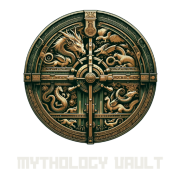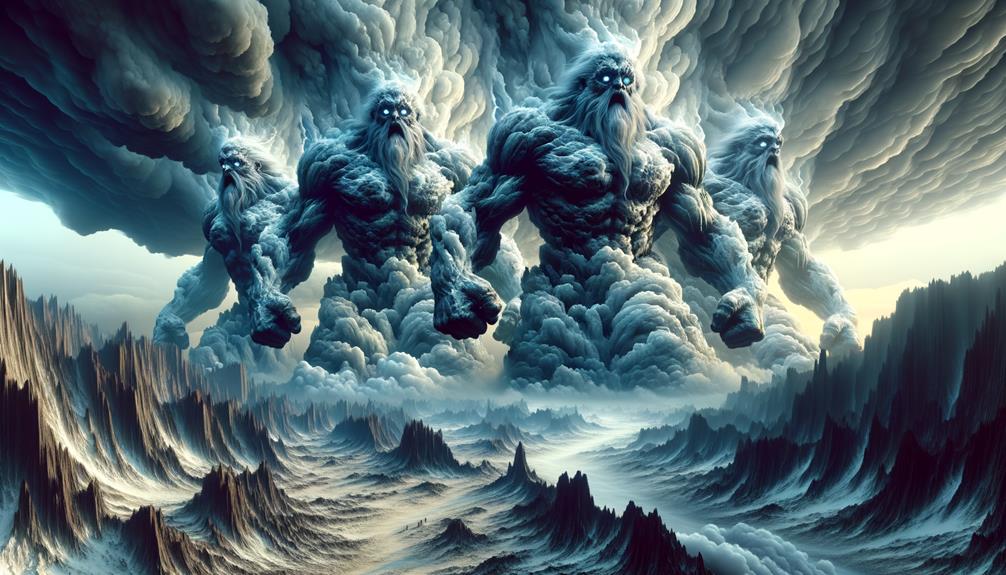I've always viewed the Hecatoncheires as symbols of nature's raw, unbridled power. Originating from Uranus and Gaia, these hundred-handed giants—Briareus, Cottus, and Gyges—combine awe and terror, embodying primordial chaos. Their hundred arms and fifty heads amplify their destructive might, representing the complex, often terrifying potential of nature. Initially imprisoned by Uranus due to their fearsome power, Zeus freed them to turn the tide in the Titanomachy war. This act symbolized recognizing and aligning with primal forces to restore cosmic balance. These mythic figures hold multifaceted archetypal themes worth exploring further.
Origins and Creation
The Hecatoncheires, Briareus, Cottus, and Gyges, emerged from the union of Uranus and Gaia, embodying nature's raw, primal forces. Their hundred arms and fifty heads symbolized the natural world's vast potential and dangers. Terrified by their immense power, Uranus imprisoned them in Tartarus. Gaia grieved their absence until her Titan son Cronus overthrew Uranus without freeing them.
Eventually, Zeus recognized the giants' strength during his clash with the Titans. He freed them, gaining invaluable allies who turned the tide for the Olympian gods. The Hecatoncheires' tale encapsulates ancient Greek perspectives on chaos versus order and unchecked versus restrained might.
Physical Characteristics
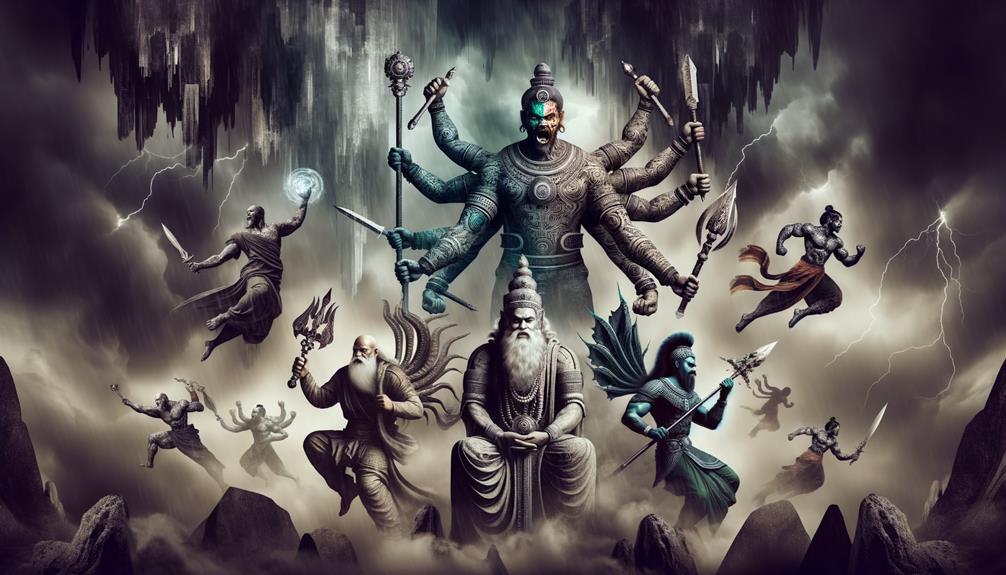
The Hecatoncheires tower over mere mortals, their imposing statures alone enough to shake the earth. Muscled arms by the hundred lash out, gripping boulders to unleash carnage in the chaos of battle. Fifty distinct heads glare from these mythological titans, each twisted visage a reflection of nature's untamed might.
The Hecatoncheires embody the primal forces of the universe as envisioned by ancient Greeks. Their sheer size and unrivaled power channel the raw energy of the natural world itself. To witness them in action inspires both awe and terror.
Immense Stature and Strength
In Greek mythology, the Hecatoncheires' towering size and immense strength confirmed their status as embodiments of raw, untamed nature. These three giants, birthed by Gaia and Uranus, commanded reverence even from gods like Zeus and Poseidon. Initially imprisoned by their father Uranus, their liberation marked a pivotal turn in the epic Titanomachy war.
The hundred-armed, fifty-headed Hecatoncheires symbolized nature's sheer power and complexity. Effortlessly hurling massive boulders, their many hands amplified their destructive capabilities. This physical dominance manifested the chaotic, overwhelming force of the natural world they represented.
Across mythologies, colossal beings often personify the untamable elements, acting as both protectors and destroyers. The Hecatoncheires encapsulate this duality, standing as enduring symbols of the formidable, unpredictable forces shaping our existence.
Multiple Arms Functionality
Their hundred arms weren't just about superior power; they represented raw, elemental chaos. With fifty heads commanding those limbs, the Hecatoncheires moved with baffling coordination, an unstoppable force too powerful for gods or mortals. This multitude of arms dominated battles, shifting conflicts with overwhelming might.
The Hecatoncheires exemplified the fusion of supreme strength and elemental turmoil across cultures, their hundred limbs a potent metaphor for untamed nature. In Greek myth, they embodied unbridled power in its rawest form.
Unique Facial Features
Greek mythology presents the Hecatoncheires as fearsome, mighty beings with a grotesque appearance – fifty distinct heads, each bearing unique facial features. This multiplicity amplifies their chaotic essence. Their individual heads could symbolize distinct perspectives and personalities, reflecting the complexity of nature's forces they embody.
The sheer number of faces and expressions creates an overwhelming, intimidating presence. This accentuates their formidable might within ancient narratives. The Hecatoncheires' multifaceted terror serves as a reminder of overwhelming primordial forces at play in mythological tales.
Each head's distinct features underscore individuality. However, together they manifest immense strength and power, representing archetypal chaos personified. Their grotesque visages leave a lasting impression, exemplifying awe-inspiring entities from mythic origins.
Mythological Roles

The mythological Hundred-Handed Giants weren't just enforcers; they symbolized nature's balance between chaotic destruction and orderly construction. As prison guards for the Titans and builders of Olympus, they embodied these contrasting yet interconnected forces. Their alliance with Zeus highlighted their cosmic significance in establishing divine authority.
Titans' Prison Guards
In Greek mythology, the monstrous Hecatoncheires—Briareus, Cottus, and Gyges—took on the role of prison guards after the Titanomachy. They were appointed by Zeus to confine the defeated Titans in the underworld of Tartarus, solidifying the new cosmic order.
Their duty as guardians embodied several key themes:
- Strategic Allies of Zeus: Initially oppressed by Uranus, the Hecatoncheires sided with Zeus during the Titanomachy. Their hundred hands and immense strength contributed to the Titans' downfall.
- Enforcers of Tartarus: As wardens of the underworld, they ensured the Titans remained imprisoned, preventing disruptions to the divine hierarchy.
- Embodiment of Cosmic Justice: Once imprisoned for their monstrous forms, the Hecatoncheires now held authority over their former captors—a symbolic shift in power dynamics.
The Hecatoncheires' role exemplified loyalty, retribution, and the maintenance of cosmic balance within Greek mythological narratives.
Builders of Olympus
The Hundred-Handed Giants, known as the Hecatoncheires, played a pivotal role in crafting Olympus, the gods' magnificent realm. With unmatched might and skill, they constructed the very foundations after Zeus freed them during the Titanomachy. Not only formidable warriors by his side, their craftsmanship transformed the divine domain into a symbol of power and beauty.
However, the Hecatoncheires represented more than mere builders. They embodied Greek mythology's contrasting themes of chaos and order. Their immense strength, though potentially destructive, was channeled into creation, reflecting a balance central to many mythological narratives.
| Hecatoncheire | Contribution | Symbolism |
|---|---|---|
| Briareus | Builder | Strength, loyalty |
| Cottus | Craftsman | Equilibrium between chaos and order |
| Gyges | Zeus' Ally | Transformation catalyst |
The Hecatoncheires' involvement underscores their redemption from feared entities to revered architects. Their story exemplifies overcoming adversity through unity, both essential mythological themes.
Key Myths
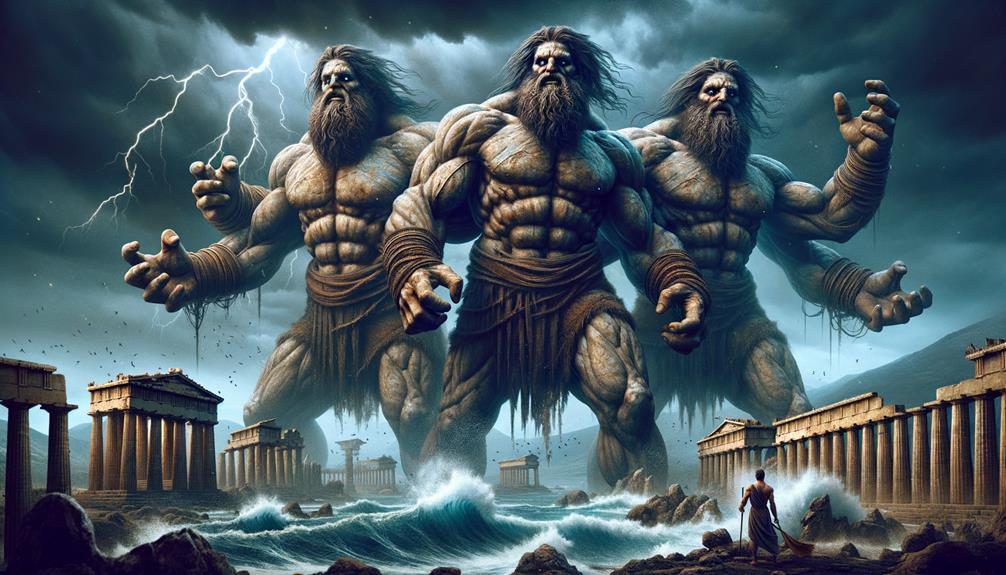
From the underworld's depths emerged the Hecatoncheires, hundred-armed giants born to Gaia and Uranus. Hidden away by their mother due to their terrifying looks, Zeus freed them during the clash against the Titans. With their countless limbs, they hurled boulders, overpowering the Titans through sheer force.
The Hecatoncheires played a pivotal role in the Titanomachy, the epic battle between Zeus's Olympians and the Titans:
- Crucial Reinforcements: Their immense strength bolstered Zeus's forces, tipping the scales.
- Enforcing Order: After victory, they guarded Tartarus, ensuring the imprisoned Titans remained subdued.
- Embodying Chaos: Representing untamed natural energy, their inclusion showcased Zeus's mastery over primal forces.
Though fearsome, these children of Gaia upheld cosmic stability under Zeus's reign. Even in divine disputes like between Poseidon and Zeus, their presence reinforced Zeus's authority. The Hecatoncheires' tales reflect the universal struggle between order and chaos echoed across mythologies worldwide.
Cultural Depictions
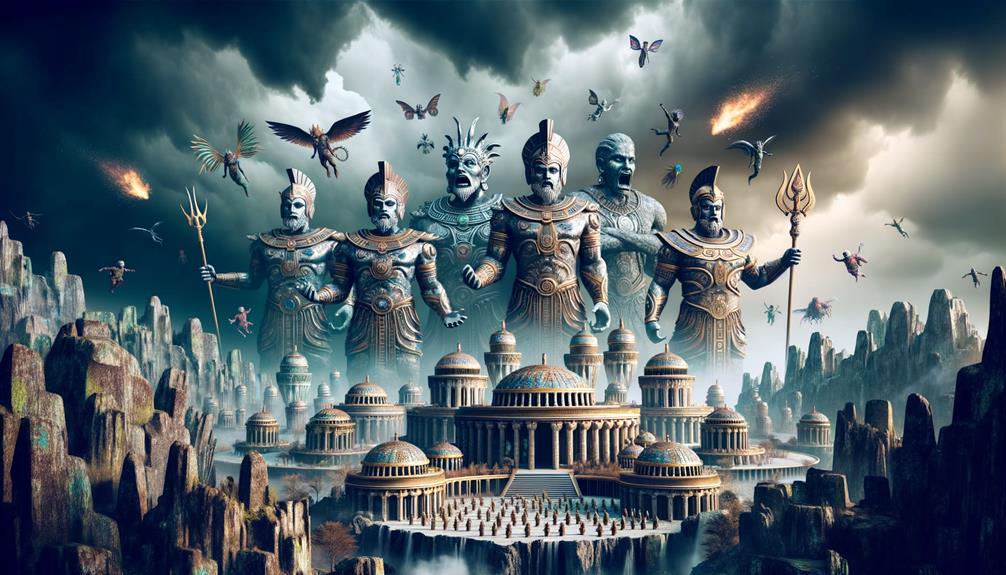
Modern gaming portrays the Hecatoncheires, the ancient Greek giants, as formidable adversaries. In Dungeons & Dragons, they embody raw power and chaos once wielded by Zeus, Poseidon, and Gaia against the Titans. Players face these colossal beings as nearly insurmountable foes, testing strategic abilities in an age-old clash of order versus chaos.
The Shin Megami Tensei series reimagines the Hecatoncheires as powerful personas or demons, reflecting their multifaceted mythological roots described by ancient poets and writers. Their strength and chaotic nature nod to archetypal themes of rebellion and brute force.
Games like God of War: Ascension showcase the Hecatoncheires' overwhelming might and fearsome presence. These depictions honor ancient myths while enriching gaming with mythological depth, transforming legends into vivid, interactive challenges captivating players.
Ancient Text References
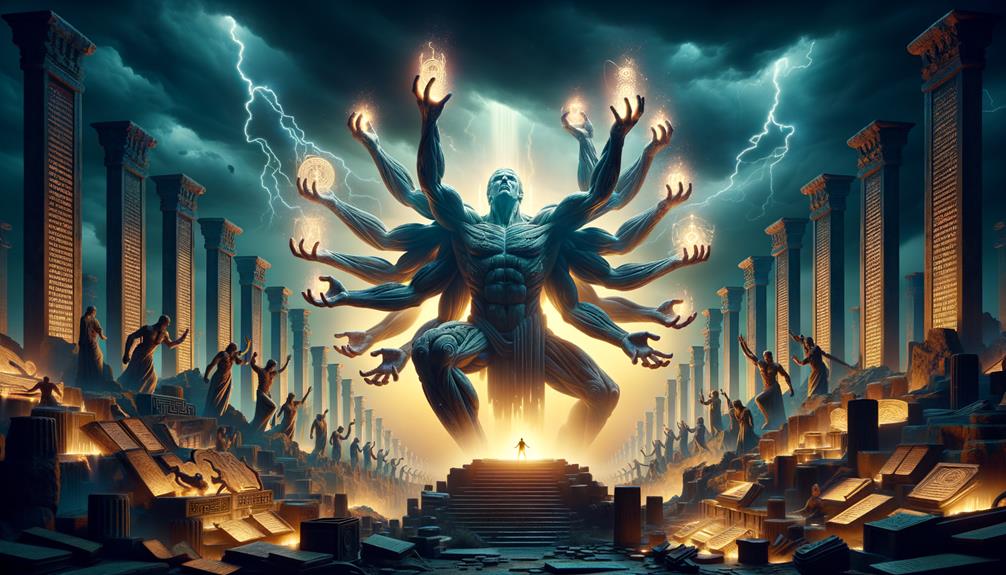
Ancient texts like Hesiod's *Theogony* paint a vivid picture of the Hecatoncheires' formidable presence and pivotal role in Greek mythology. Born to Uranus and Gaia, these Hundred-Handed Giants were initially imprisoned in Tartarus by Uranus due to their terrifying appearance. Hesiod's account emphasizes their significance, revealing how Zeus eventually freed them during the Titanomachy, a major battle against the Titans.
The Hecatoncheires' narrative in the *Theogony* unfolds in three key episodes:
- Imprisonment by Uranus: Themes of fear and rejection as the Hecatoncheires were confined in the dark abyss of Tartarus.
- Liberation by Zeus: During the Titanomachy, Zeus strategically freed them, recognizing potential allies.
- Role as Guardians: After victory, they were appointed guardians of Tartarus, symbolizing restored order and divine justice.
These episodes illustrate archetypal themes of imprisonment, liberation, and guardianship. The Hecatoncheires' story underscores their enduring importance, inextricably linking them to Zeus, the Titans, and the cosmic order maintained in Tartarus' depths.
Frequently Asked Questions
Who Are the 100 Handed Giants in Greek Mythology?
The titans Briareus, Cottus, and Gyges were immensely powerful beings with a hundred hands each. Born to the primordial deities Uranus and Gaia, they embodied raw strength and chaos itself. When the Titans challenged the Olympian gods, these monstrous giants allied with Zeus, lending their formidable might to his cause during the Titanomachy war. Their inclusion in Greek myth reflects ancient narratives that explored themes of untamed natural forces confronting the realms of order and civilization.
How Many Hands Did the Hecatoncheires Have?
Each Hecatoncheir possessed a hundred hands, symbolizing immense strength and primal force in Greek mythology. This multitude of arms represented unbridled power and chaos – core themes reflected in these mythological figures.
What Is Hecatoncheires the God Of?
In mythology, the Hecatoncheires personified primordial chaos and raw, overwhelming natural forces. They weren't deities per se, but embodied the untamed, primal power of the earth. They aided Zeus and represented the struggle against cosmic disorder.
How Tall Were the Hecatoncheires?
Analyzing Greek myths, the Hecatoncheires' exact height wasn't mentioned, but their massive size symbolized untamed strength and primal power. These giants embodied raw, unrestrained forces of nature, underscoring their role as formidable, chaotic beings in ancient Greek storytelling.
